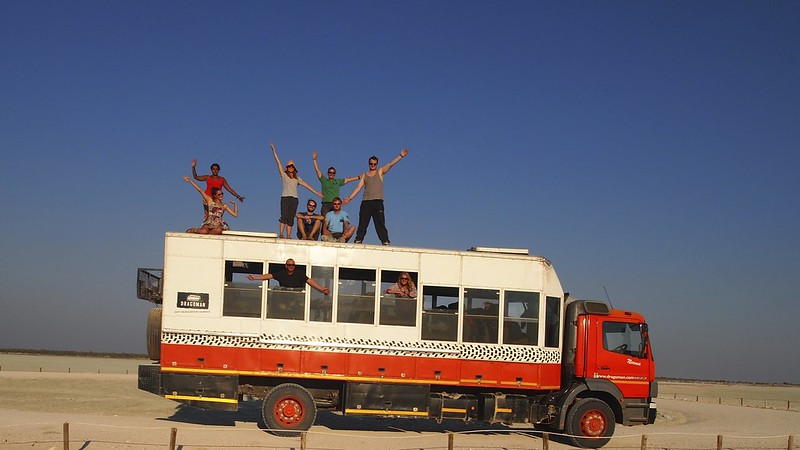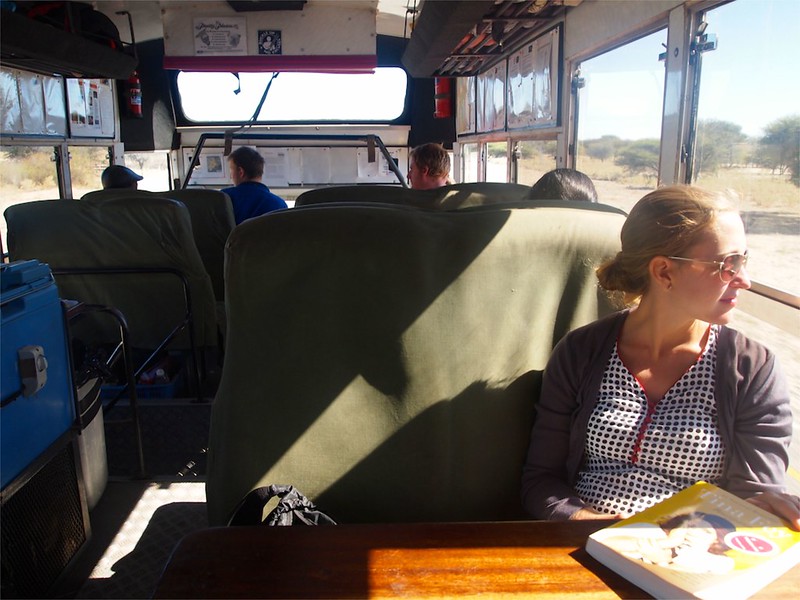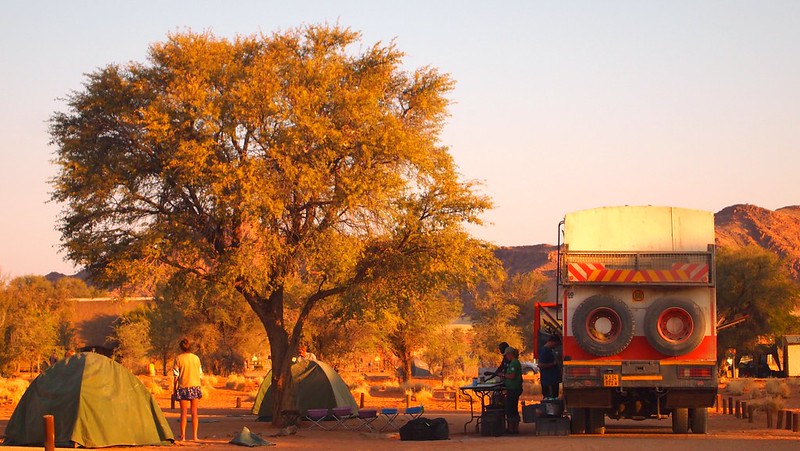Truck Life: A day in the life of our African Overland Safari
We spent 24 days traveling from Victoria Falls, Zimbabwe through Botswana and Namibia to Cape Town, South Africa with Dragoman, a UK-based overlanding company. This was a completely new mode of travel for us, and before we left, we didn’t really know what to expect. What is overlanding? Would we be bored? Would the food suck? Would our travel companions be even worse? Would Skyler survive three weeks in a tent? Read on for the answers.
What is overlanding?
Overlanding is a style of travel, especially common in Africa, where you travel from point-to-point in specially outfitted trucks, usually camping along the way and pitching in with chores like setting up camp and prepping dinner. Africa is an expensive place, but overlanding is a way to save money over the ultra-expensive private game lodges and luxury safaris. We saw lots of other overlanding trucks, and there is a large difference in just how plush your overlanding experience can be. We saw trucks with large crews where the passengers never had to put up their own tents, had hot water drawn for them nightly, etc. We saw other trucks with cheap-looking equipment, no cook (more on how awesome that was later), and lots of pay-for-them-extra activities. I think Dragoman hit a nice medium on this spectrum. You can read more about why we chose this type of trip here.
Wait … you have to help with chores?
These were seriously no big deal. Everyone had a “truck job.” Skyler’s was to sweep the truck every few days and mine was to help another guy load/unload everyone’s packs from the locker underneath the truck. Other people loaded/unloaded tents, tables, and kitchen gear, or were in charge of keeping things locked up and safe. In addition, everyone is assigned to a 3-person cook group that every few days helps the cook prep dinner and scrub pots and pans. The most we ever did here was chop a few onions, no big deal!
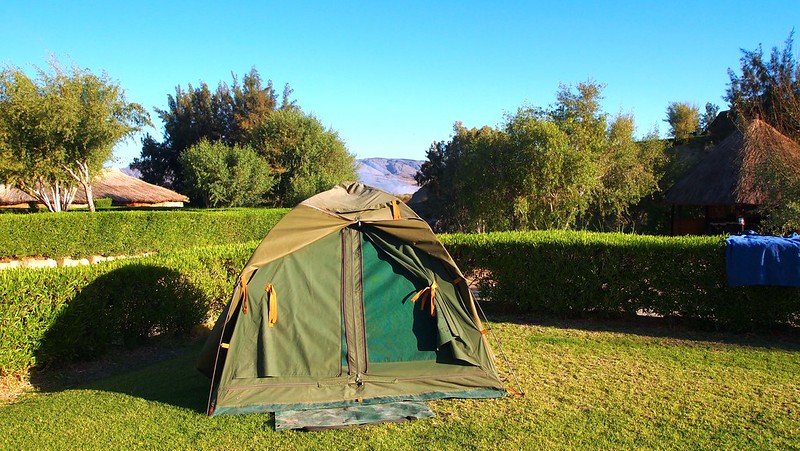
How was the group?
We had a crew of 3 — a Finnish trip leader and a Kenyan driver and cook. The guys from Kenya were invaluable, having driven this route so many times they knew each little town and campsite like the back of their hands. Our trip leader, Tanja, was leading her first-ever trip and did a good job keeping us organized and on schedule. Apparently some extremely budget overlanding companies don’t include a cook, but having a cook was one of the best parts about the entire overlanding experience. It was so nice having a hot meal waiting on us after a long day of game drives or eggs and coffee ready to go on early chilly mornings. Without a cook, the passengers have to plan for, shop for, and cook every meal. No thanks — way too stressful and time consuming. And Charles and Samson (our two cooks) were awesome! Good food, pleasant company, and (with Samson) sweet dance moves!
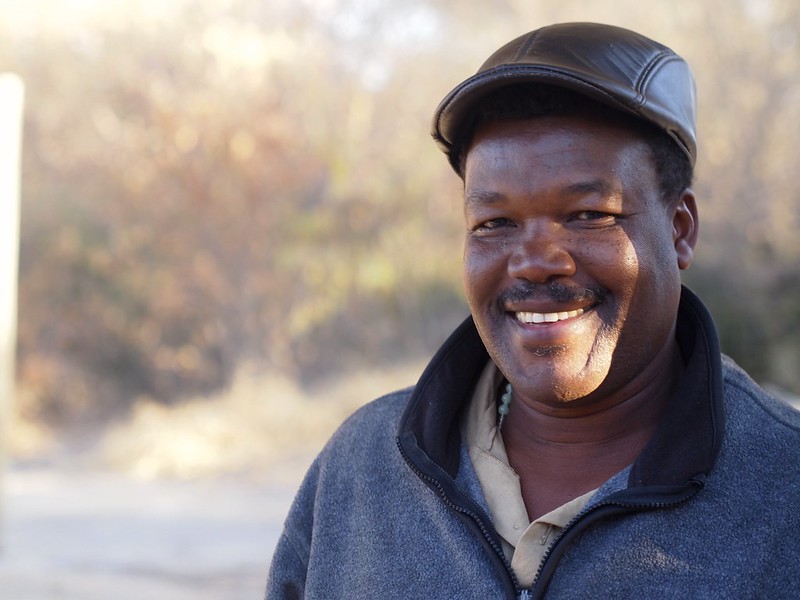
Though the truck can fit up to 24, we only had 6 other people in our group. Five of the six were from the UK (an older couple, two young solo guys and a solo woman in her 40s). Our sixth was a young woman from Australia traveling by herself. They all started on the truck earlier than us — either in Nairobi or Dar es Salaam — but graciously welcomed us with open arms. We got along with them really well — and Skyler won’t mind if I say it was nice having someone new to talk to after six months of traveling together. We thought the small group size was a huge plus — it meant we could all stretch out on our own seats on the truck and the singles could all have their own tents.
What’s a typical day like?
We spent 24 days on the truck and each day varied quite a bit — some days were really long drives while at other times we’d stay put for a couple of nights or just make short drives from point-to-point. Here is an example of a typical long driving day.
5:30 AM
I never knew of a morning in Africa when I woke up that I was not happy
– Ernest Hemingway
Alarms are going off in neighboring tents, folks are stirring — time to get up. I typically spend 5 minutes overcoming the urge to stay in my warm and cozy sleeping bag (it’s cold and dark outside). I eventually stuff the sleeping bag into its bag, the bag into my pack, and the pack into the truck. Then, under the light of our head lamps, we take down the tent, and get that onto the truck as well. (Note from Skyler: I always felt that Jordan was unfairly like an Energizer bunny on these mornings, getting chores done with cheerful ease, while I struggled to stuff my sleeping bag into its recalcitrant bag with my frozen, numb fingers, mumbling curses under my breath. Things looked significantly up after breakfast.)
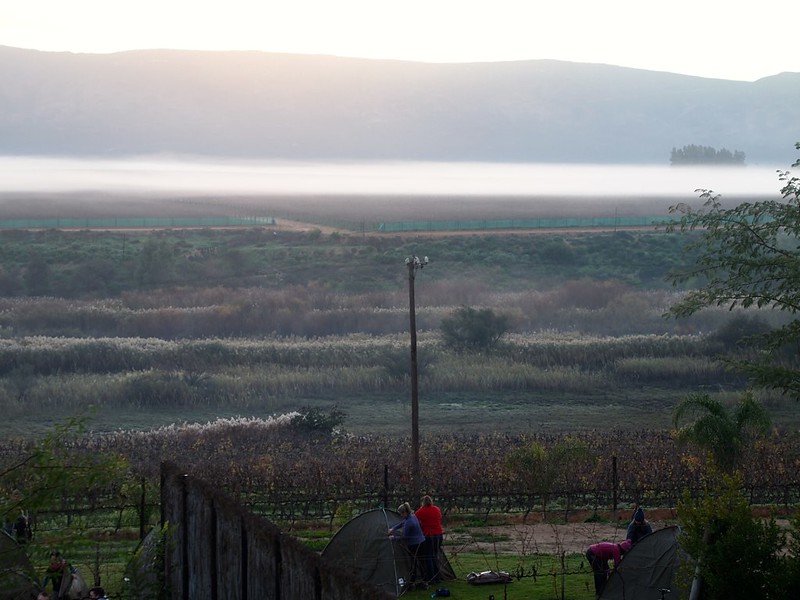
6:00 AM
Breakfast! Our cook has hot water going for tea and coffee, a pot of hot oatmeal, all sorts of cereals with milk and yogurt, and is cooking toast and eggs to order. Every now and then we’re also treated to bacon and — for the Aussies and Brits — baked beans.
After breakfast, we wash our plates, flap them dry, load up the truck, brush our teeth, and hit the road.
(A short note on flapping: A particular rite of overlanding passage, “flapping” refers to the action of moving plates, pans, and other clean kitchen implements back and forth in the air in order to get them dry after they’ve been washed. No one liked doing it, but we did make up great flapping parodies such as, “Tonight I’m Flapping You” by Enrique Iglesias or “The Final Flapdown.”)

7:00 AM
We usually snooze as best we can for a bit while Arthur or Tanja drives us to our next destination. Once we’ve woken up and thawed out a bit, we’d read books, play cards on the tables in the back, chat, listen to music, and generally kill time on the truck. I’m usually distracted simply watching the incredible landscapes go by.
Every few hours we stop for bathroom breaks — we’re in the middle of nowhere, so this means boys on one side of the road, girls on the other. On some days we stop in a town for an hour or two for the crew to buy groceries while we go to ATM’s or Internet cafes. Amazing discovery: we didn’t check the website or our email for an entire week or more and nothing happened! This led to the realization that we are addicted to the Internet and we vow to cut back on our usage.
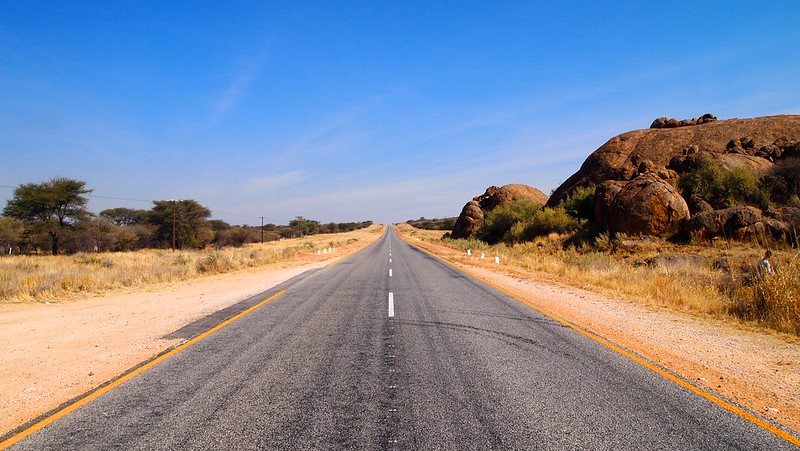
1:00 PM
We find a shady picnic spot to pull over for lunch. The whole kitchen ensemble, along with dishwashing stations and camp chairs, has to be pulled out of the truck. Lunch is typically fresh salad, lunch meats, bread for sandwiches, yesterday’s dinner leftovers, and sliced fruit. After lunch, we do the whole thing in reverse.
This sounds tedious, but our group was awesome — lunch became like a Nascar pit stop. Set up, eat, wash and break down in half an hour!
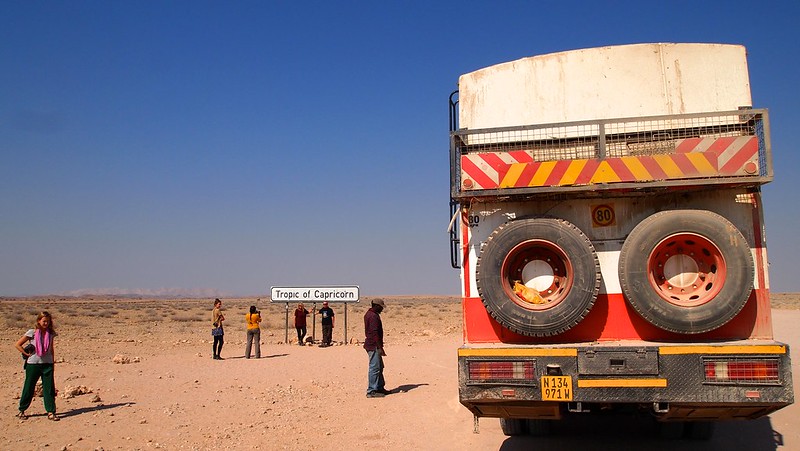
4:00 PM
We’ll arrive at our campsite sometime in the afternoon, depending on the length of the drive. First order of business is setting up the camp — pitching tents, unloading packs, and helping the cook set up the kitchen. Sometimes we have an afternoon game drive or pre-arranged activity. Otherwise we’re on our own until dinner. The Brits hit the pub, the girls typically grab a shower. We find that the further south we go, the nicer the campsites are and the higher the likelihood for a hot shower becomes. Most of the campsites in Namibia are as nice or nicer than anywhere I’ve camped in the US. (Skyler’s note: Don’t underestimate the power of a hot shower when it’s freezing outside. If the water was cold, we all typically did without. I flouted this one night and went to bed with cold hair after a cold shower on a cold night and couldn’t sleep I was shivering so hard. Better to be a bit stinky.)
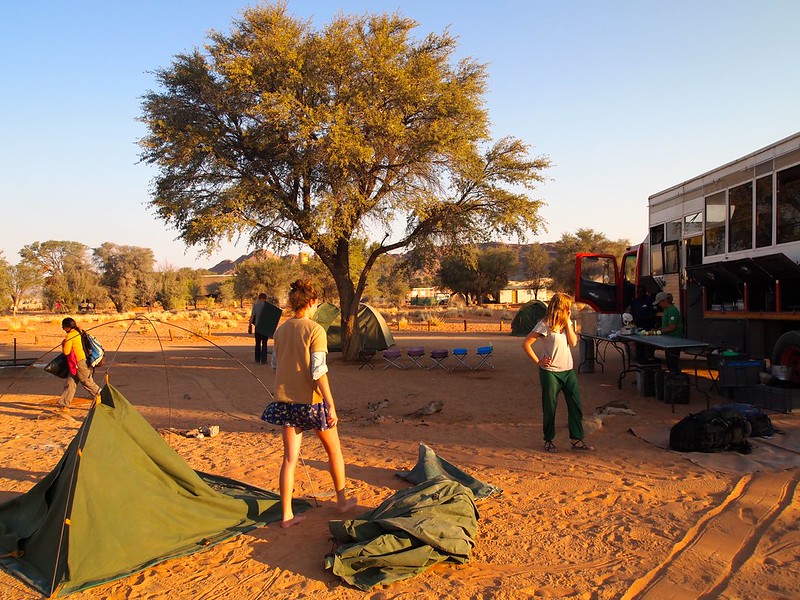
7:00 PM
Dinner time! Dinner always varied — steaks or pork chops, lamb curries, burgers, meatballs — always with lots and lots of veggies, often mashed potatoes too. We ate really well on this trip. We always go back for seconds and we always say we ate too much. I think we definitely put back on the weight we lost in India.
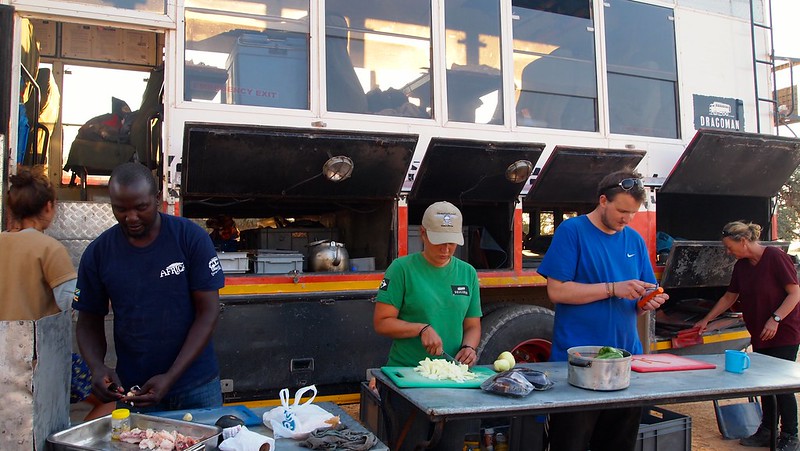
After dinner, that day’s designated cook group does the dishes, everyone flaps them dry, and we drink and chat around the campfire until everyone goes to bed.
9:30 PM
It’s cold, it’s been dark for 3 hours or more, the campfire is dying down, and by 9:30, we’re usually zipped up tight in our sleeping bags, listening to the growls of lions or the grunts of hippos — and hoping we don’t have to get up in the middle of the night to go pee.
Would we try overlanding again?
Yes! Overlanding was a great decision for us and I would highly recommend it. We feel that it offers a great value-for-money experience in an expensive continent. We got to meet nice people, saw some beautiful places, and had some amazing experiences. We also enjoyed having everything planned for us for a few weeks — it really felt like we were on vacation.
Our only caveat is that you should know what you’re signing up for. These trips are not for people looking to do Africa in luxury. We actually enjoyed the tent camping (Skyler was a champ, going from a novice camper to three straight weeks!). Fresh air, hearing the animals at night, the feeling of self sufficiency — it was all great! But a fancy game lodge experience it is not. Also, not all overlanding companies are created equal. Some offer more activities, nicer trucks, more crew. We wouldn’t have gone any more “budget.” We had a nice truck, good quality equipment, good and plentiful food, plenty of included activities, and a great crew. These are all factors to consider, and we wouldn’t book an overlanding trip without a cook!
The other option we had discussed was renting a vehicle and doing this trip independently. Having seen it now, Southern Africa would be really quite easy to do on your own. Several companies rent out 4×4 trucks with all the necessary camping equipment, the roads are good, the campsites are great, and every little town is equipped with well-stocked supermarkets, ATM’s, Internet cafes, etc. There are several downsides to this strategy, however. It’s expensive and many popular campsites book up months in advance, requiring some advance planning. Still, if we came back to this part of Africa, we’d seriously consider this option, especially if we had other people with us to split the costs of the vehicle, fuel, and food.
Africa wasn’t a part of our original itinerary, but we came and fell in love with it. Those three weeks on the truck, something we were so nervous about, actually turned into the highlight of our entire year so far. Africa, we’ll be back!
All I wanted to do now was get back to Africa. We had not left it yet, but when I would wake in the night, I would lie, listening, homesick for it already.
– Ernest Hemingway, seconded by Jordan and Skyler

